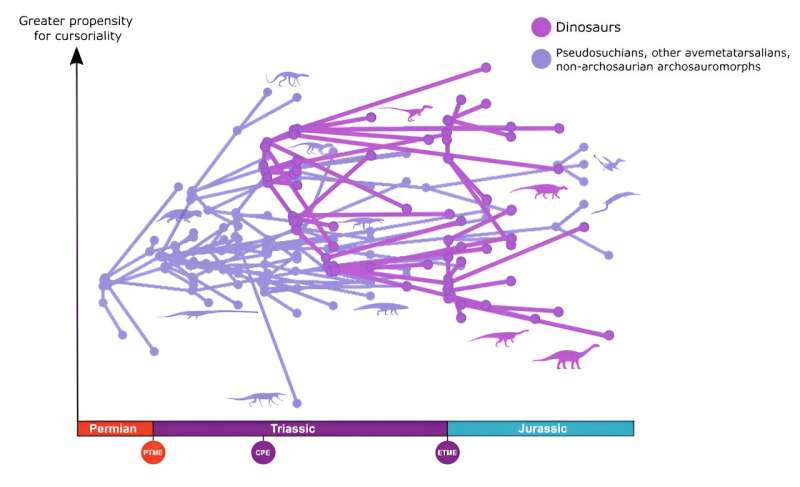This article has been reviewed according to Science X's editorial process and policies. Editors have highlighted the following attributes while ensuring the content's credibility:
fact-checked
peer-reviewed publication
trusted source
proofread
Dinosaurs' success helped by specialized stance and gait, study finds

Dinosaurs' range of locomotion made them incredibly adaptable, University of Bristol researchers have found. In a new study, published today in Royal Society Open Science, findings show that the first dinosaurs were simply faster and more dynamic than their competitors, and it's why they were able to dominate the Earth for 160 million years.
The researchers compared the limb proportions of a broad array of reptiles from the Triassic, the period of time from 252 to 201 million years ago, when dinosaurs first appeared and rose to prominence. They identified which of these ancient beasts was quadrupedal (four-footed) or bipedal (two-footed), and also looked at their cursoriality index, a measure of their running ability.
They found that, from the beginning, not only were the dinosaurs and their close relatives bipedal and cursorial—which meant they had limbs adapted for running, they also showed a much wider range of running styles than some of their close competitors, called the Pseudosuchia.
The pseudosuchians included the ancestors of modern crocodiles. Some were small insect-eating bipeds, but most were medium-to-large-sized carnivores and herbivores and they were diverse throughout the Triassic. The team found that dinosaurs and their kin, the Avemetatarsalia, maintained a higher range of locomotory modes throughout this period.
MSc Palaeobiology student Amy Shipley led the study. She said, "When the crunch came, 233 million years ago, dinosaurs won out.
"At that time, climates went from wet to dry, and there was severe pressure for food. Somehow the dinosaurs, which had been around in low numbers already for 20 million years, took off and the pseudosuchians did not.
"It's likely the early dinosaurs were good at water conservation, as many modern reptiles and birds are today. But our evidence shows that their greater adaptability in walking and running played a key part."
"After the end of the Triassic, when there was a mass extinction, the dinosaurs expanded again," said Professor Mike Benton. "Most of the pseudosuchians were wiped out by the mass extinction, except for the ancestors of crocodiles, and we found that these surviving dinosaurs expanded their range of locomotion again, taking over many of the empty niches."
Co-author Dr. Armin Elsler explained, "When we looked at evolutionary rates, we found that in fact dinosaurs were not evolving particularly fast.
"This was a surprise because we expected to see fast evolution in avemetatarsalians and slower evolution in pseudosuchians. What this means is that the locomotion style of dinosaurs was advantageous to them, but it was not an engine of intense evolutionary selection. In other words, when crises happened, they were well placed to take advantage of opportunities after the crisis."
"We always think of dinosaurs as huge and lumbering," says Dr. Tom Stubbs, another collaborator. "This reminds us that actually the dinosaurs started as nippy little insect-eaters.
"The first dinosaurs were only a meter long, up high on their legs, and bipedal. Their leg posture meant they could move fast and catch their prey while escaping larger predators."
Co-author Dr. Suresh Singh concluded, "And of course, their diversity of posture and focus on fast running meant that dinosaurs could diversify when they had the chance.
"After the end-Triassic mass extinction, we get truly huge dinosaurs, over 10 meters long, some with armor, many quadrupedal, but many still bipedal like their ancestors. The diversity of their posture and gait meant they were immensely adaptable, and this ensured strong success on Earth for so long."
More information: Amy E. Shipley et al, Locomotion and the early Mesozoic success of Archosauromorpha, Royal Society Open Science (2024). DOI: 10.1098/rsos.231495
Journal information: Royal Society Open Science
Provided by University of Bristol





















